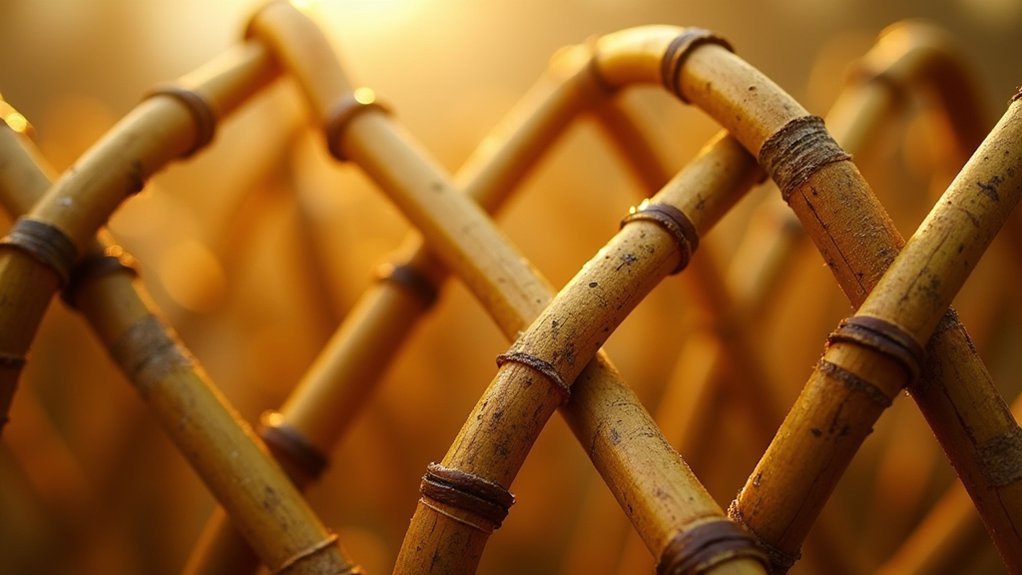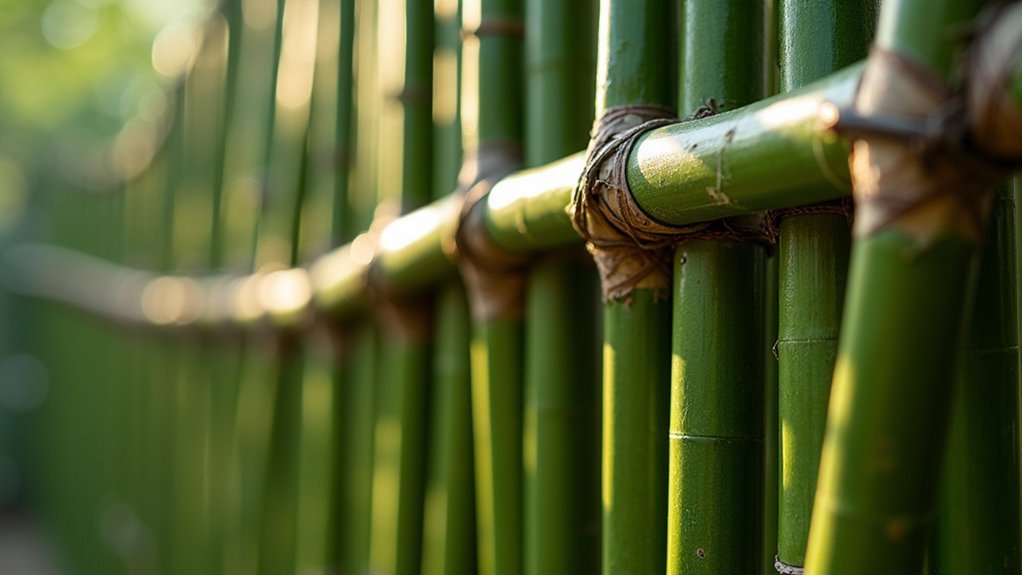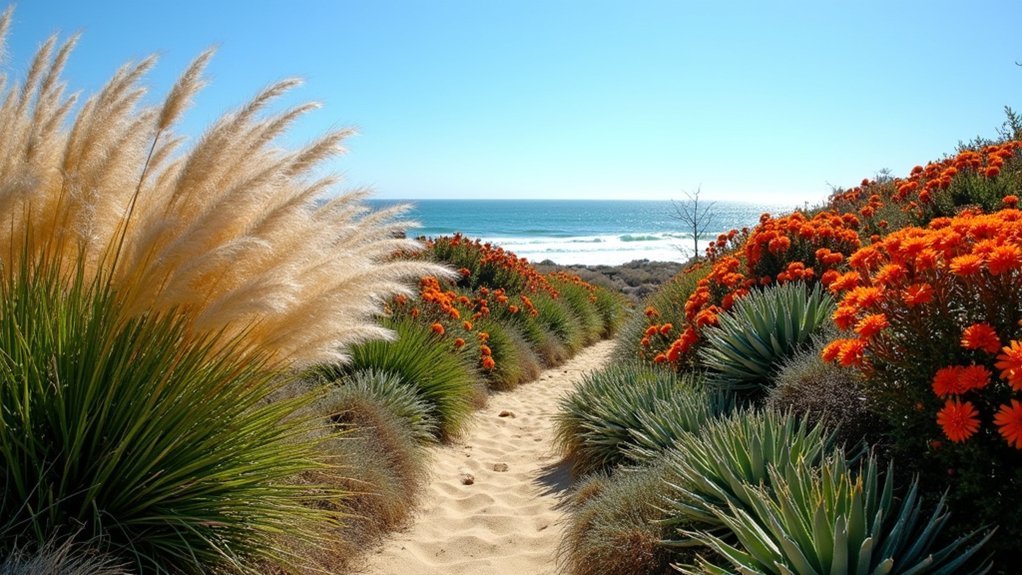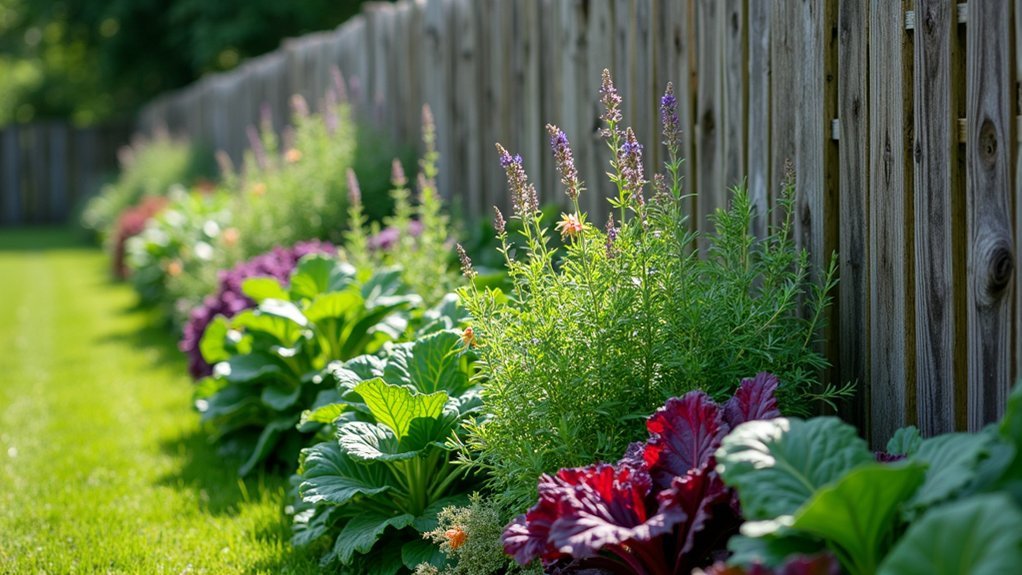Curved bamboo fences resist environmental forces through their ingenious design. The curved shape distributes pressure evenly while bamboo’s natural flexibility allows it to bend without breaking, absorbing wind energy rather than fighting it. With tensile strength averaging 160 N/mm², the tubular structure creates an impressive strength-to-weight ratio. When properly installed with concrete footings and maintained with regular sealing, your bamboo fence can last over 20 years. Discover how this ancient building technique continues to outperform modern alternatives.
The Science Behind Curved Bamboo Design

While traditional fencing often relies on rigid structures, curved bamboo designs harness fundamental scientific principles to create both functional and beautiful boundaries. The curved architecture distributes forces evenly throughout the fence, notably enhancing structural stability compared to straight designs.
You’ll notice bamboo’s impressive tensile strength allows these fences to withstand substantial loads without breaking. When forces impact the fence—whether from wind, water, or physical contact—the curved shape efficiently dissipates energy across its entire structure.
This energy dissipation is further enhanced by the material’s natural flexibility and porosity. The cross-sectional flexibility of bamboo enables the fence to bend rather than break under pressure, while its porous nature allows airflow and water passage, reducing direct resistance that might otherwise cause structural failure. Studies conducted in Vietnam demonstrate that bamboo fence structures can reduce wave energy by up to 63%, making them particularly effective for coastal protection applications.
Wind Resistance Properties of Curved Fences
Curved bamboo fences excel particularly in their response to one of nature’s most persistent forces: wind. Unlike rigid structures that fight against gusts, bamboo’s natural flexibility allows it to bend without breaking, effectively dissipating wind energy.
Nature’s engineering at its finest—bamboo bends with the wind rather than fighting against it.
The curved design creates an aerodynamic profile that disrupts airflow, while the fence’s porosity lets air pass through rather than creating a pressure differential. You’ll find this combination dramatically reduces the force exerted on the structure.
When installing your curved bamboo fence, consider height variations to match local wind conditions. Taller options like our 72 H x 96 L bamboo fences provide excellent wind protection while maintaining flexibility. Choose mature varieties like Moso bamboo for added durability, and incorporate proper structural supports.
The rolled bamboo design offers exceptional flexibility in windy areas. With regular maintenance and ground clearance to prevent moisture damage, your curved bamboo fence will withstand years of wind exposure.
Structural Advantages of Tubular Bamboo Canes

The remarkable tubular structure of bamboo canes provides exceptional strength-to-weight advantages that make them ideal for fencing applications.
You’ll find that bamboo’s natural hollow design maximizes structural efficiency while minimizing material usage, creating a fence that’s both sturdy and lightweight.
The tubular design offers three key benefits:
- Axial fiber orientation – Bamboo’s fibers run lengthwise, providing impressive tensile strength that withstands pulling forces better than many conventional materials.
- High elasticity – The natural flexibility allows your fence to bend rather than break during high winds or impacts, making it perfect for seismic zones.
- Consistent performance – Unlike wood that varies throughout, bamboo’s uniform tubular shape delivers reliable structural integrity across its entire length, ensuring your fence maintains stability over time.
The curved bamboo fence designs showcase bamboo’s superior structural properties, with tensile strength averaging around 160 N/mm², significantly outperforming conventional woods used in fencing applications.
Installation Techniques for Maximum Durability
Ensuring your curved bamboo fence stands the test of time requires meticulous installation techniques that address both structural integrity and environmental challenges. Begin with proper foundation stabilization—secure your posts with concrete grouting and implement drainage systems to prevent water damage.
When creating curves, make V-shaped cuts or use steam bending techniques while supporting the bamboo with temporary frames to maintain shape without compromising strength. Apply a quality UV protectant sealant to extend the lifespan of your bamboo fence outdoors.
| Technique | Purpose |
|---|---|
| Screwing vs. Nailing | Prevents splitting while securing joints |
| Invisible Fasteners | Maintains natural aesthetic appearance |
| Adjustable Connectors | Accommodates natural bamboo shrinkage |
Don’t forget post-installation care—apply protective coatings seasonally and conduct regular inspections. You’ll need to trim and repair any compromised sections promptly to extend your fence’s lifespan while preserving its unique curved design.
Weatherproofing Methods for Curved Bamboo Structures

Successfully weatherproofing curved bamboo fences requires specialized techniques that address their unique structural demands and natural vulnerabilities.
You’ll need to implement proper material preparation alongside strategic design adaptations to guarantee longevity.
Your weatherproofing strategy should include:
- Chemical treatments – Apply borate-based solutions to enhance fire resistance while protecting against fungi, followed by copper-based sealants that work with bamboo’s flexibility to resist moisture.
- Structural considerations – Maintain a design that promotes rapid water runoff, with particular attention to curvilinear cross-bracing that reinforces against wind shear. For optimal protection, a minimum pitch of 40 degrees should be incorporated, similar to requirements for flattened bamboo roofing systems.
- Maintenance schedule – Perform biannual inspections, focusing on membrane integrity and joint resealing, while guaranteeing you reapply UV-resistant topcoats to counter solar degradation every 2-3 years.
Climate-specific adaptations are essential – humid environments require monthly antifungal treatments, while coastal areas demand stainless-steel fasteners.
Traditional vs. Modern Curved Fence Construction
While traditional curved bamboo fences reflect centuries of cultural heritage and craftsmanship, modern construction techniques have revolutionized how these elegant structures are designed and built.
Traditional methods like rup-rup with full-round poles and split member techniques achieve curvature through careful selection and placement, creating rustic aesthetic appeal.
In contrast, modern approaches incorporate engineered bamboo products and advanced tools that enhance precision and structural complexity.
You’ll find that traditional construction is typically more labor-intensive but less expensive, while modern methods offer greater design flexibility and improved sustainability.
Both approaches have their strengths: traditional fences showcase authentic craftsmanship with natural bamboo forms, while modern techniques allow for complex designs and material optimization.
Your choice between these methods will depend on your desired aesthetic, budget constraints, and structural requirements.
The different cross-sections of bamboo significantly impact flexibility, with lidi bundles offering superior curvature capabilities compared to full poles or splits when creating organically curved fence designs.
Soil Consideration and Foundation Requirements

Proper soil assessment and foundation design form the backbone of any durable curved bamboo fence installation.
You’ll need to take into account soil pH and moisture levels, as high organic content can accelerate bamboo degradation through increased microbial activity. Sandy soils offer better drainage, reducing rot risks.
For long-lasting stability, focus on these foundation essentials:
- Install concrete footings to elevate bamboo off the ground, preventing direct soil contact and subsequent decay.
- Incorporate drainage systems around foundations to manage water runoff and avoid moisture accumulation.
- Verify proper soil compaction around anchoring points to prevent settling and maintain the fence’s curved integrity.
Remember that your foundation’s depth should comply with local building codes and soil conditions.
Conducting a geotechnical survey before construction will save you significant maintenance headaches down the road. These foundations must be designed to provide insect protection, particularly against termites that can quickly destroy bamboo structures.
Maintenance Strategies for Long-Term Resilience
Maintaining your curved bamboo fence requires a systematic approach to assure its longevity and aesthetic appeal.
Begin with regular cleaning using a bamboo-specific solution, allowing it to soak for 15-30 minutes before scrubbing with a nylon brush.
For optimal maintenance, soak bamboo in specialized cleaning solution before gentle scrubbing with nylon bristles.
Always verify complete drying before applying sealants or stains. When treating your fence, lightly sand surfaces first to improve adhesion, then apply bamboo-specific sealers that protect against UV rays and moisture. Plan to re-seal about one year after installation, then as needed.
Conduct yearly inspections of all fasteners, brackets, and posts, tightening loose components and checking for rust.
Keep your fence elevated from direct soil contact and remove debris regularly to prevent moisture accumulation. With proper care and maintenance, your bamboo fence can last 20 years or more, making it a durable long-term investment. Schedule all maintenance activities during dry weather for ideal results.
Frequently Asked Questions
How Do Curved Bamboo Fences Affect Surrounding Property Values?
Curved bamboo fences can boost your property’s value by adding unique curb appeal, eco-friendly credentials, and low-maintenance durability. They’ll attract millennial buyers and differentiate your home in competitive markets.
Can Bamboo Fences Deter Specific Wildlife From Entering Gardens?
Yes, bamboo fences can deter wildlife like deer and stray animals. You’ll find thorny varieties particularly effective. When planted closely, they’ll create dense barriers that discourage animals from entering your garden space.
What Cultural Symbolism Do Curved Bamboo Fences Hold Globally?
Curved bamboo fences symbolize fluidity and harmony with nature in your space. You’ll find they represent adaptability in Japanese gardens, resilience in Chinese tradition, and now embody sustainability and peaceful contemplation globally.
How Do Bamboo Fences Compare Acoustically to Other Fencing Materials?
You’ll find bamboo fences offer moderate acoustic performance compared to dense materials like concrete. They’re more effective than metal fences, especially when densely planted, but you’ll need additional materials for ideal noise reduction.
Are There Regulations Restricting Bamboo Fence Height in Residential Areas?
Yes, you’ll typically find height restrictions for bamboo fences in residential areas. Local zoning laws often limit fences to around 6 feet tall. Always check your specific municipal codes before installation.
In Summary
You’ll find curved bamboo fences outlast their straight counterparts due to ingenious engineering principles. Their curved design distributes force evenly, while bamboo’s hollow structure offers flexibility without breaking. When properly installed with adequate foundations and treated with modern weatherproofing, your curved bamboo fence won’t just survive storms—it’ll thrive for decades. Remember, regular maintenance checks combined with these natural advantages guarantee you’re investing in both beauty and remarkable resilience.





Leave a Reply